Here are 12 important functions that can make your life easier in your car.
Window lock
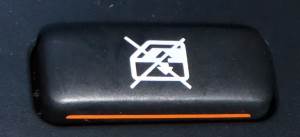 The window lock prevents rear seat passengers opening their windows. It’s usually a button that looks like a window with a cross through it, situated on the driver’s door.
The window lock prevents rear seat passengers opening their windows. It’s usually a button that looks like a window with a cross through it, situated on the driver’s door.
Cruise control
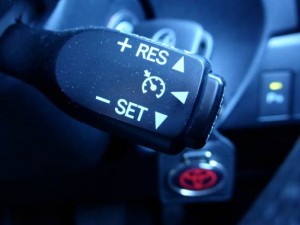 Cruise control will maintain your vehicle at a consistent speed until you use the brakes, deactivate the cruise control or press the accelerator. If you only press the accelerator once you lift off the accelerator the car will slow back down to the previous cruise control speed. Pressing the brake deactivates cruise control.
Cruise control will maintain your vehicle at a consistent speed until you use the brakes, deactivate the cruise control or press the accelerator. If you only press the accelerator once you lift off the accelerator the car will slow back down to the previous cruise control speed. Pressing the brake deactivates cruise control.
Some cars have options to accelerate or decelerate using buttons on a stalk or on the steering wheel. Some newer cars come with radar cruise control which will adjust your speed based on the speed of the car in front.
Hazard warning lights
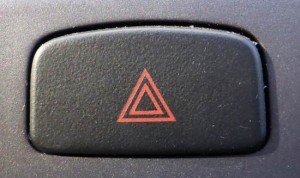 Hazard warning lights are usually activated by a button in the centre of the dashboard that looks like a red triangle. You should use your hazard warning lights if your vehicle is a temporary obstruction.
Hazard warning lights are usually activated by a button in the centre of the dashboard that looks like a red triangle. You should use your hazard warning lights if your vehicle is a temporary obstruction.
You can tell that the hazard warning lights are on because both indicator lights in the instrument cluster will flash simultaneously.
Parking sensors
![]() Parking sensors can be fitted to the front and rear of the car. They will alert you if you are getting too close to an object. However, they’re not so good at picking up thin posts and poles. You can also turn the parking sensors off temporarily by pressing a button that should look similar to this.
Parking sensors can be fitted to the front and rear of the car. They will alert you if you are getting too close to an object. However, they’re not so good at picking up thin posts and poles. You can also turn the parking sensors off temporarily by pressing a button that should look similar to this.
Voice commands
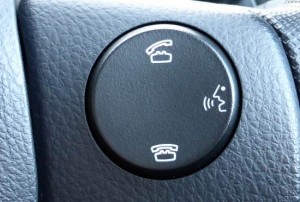 Some newer cars come with a voice command option to access vehicle functions. You simply press the button on the steering wheel and say what you want to do. Often these are connected with cellphone integration and the entertainment system. Check the manual for the exact commands you can use.
Some newer cars come with a voice command option to access vehicle functions. You simply press the button on the steering wheel and say what you want to do. Often these are connected with cellphone integration and the entertainment system. Check the manual for the exact commands you can use.
The image shown is from a Toyota steering wheel and the button has options to answer and hang up a phone call.
Child safety locks
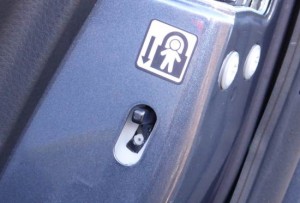 If you open a rear door you will find a small latch which prevents the door from being opened from the inside. This is to stop small children opening the door while the car is moving. If you were wondering “Why won’t my rear door open from the inside?” this will probably be the reason.
If you open a rear door you will find a small latch which prevents the door from being opened from the inside. This is to stop small children opening the door while the car is moving. If you were wondering “Why won’t my rear door open from the inside?” this will probably be the reason.
Wing mirror adjustment
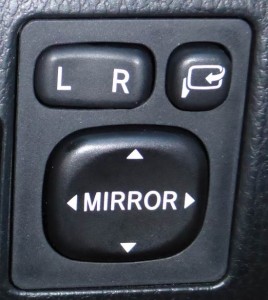 Wing mirrors should be adjusted so that you can only just see your car in them. This will give you the maximum view up the road. The wing mirrors are mostly adjusted electronically now, and there will be some kind of selector for which side you are choosing, and a controller to adjust the position. Some vehicles will automatically adjust the passenger (and sometimes driver) mirror downwards for reversing.
Wing mirrors should be adjusted so that you can only just see your car in them. This will give you the maximum view up the road. The wing mirrors are mostly adjusted electronically now, and there will be some kind of selector for which side you are choosing, and a controller to adjust the position. Some vehicles will automatically adjust the passenger (and sometimes driver) mirror downwards for reversing.
Some cars have specific memory options to remember the mirror and seat settings for different drivers.
The image shows an extra button to fold in the mirrors.
Volume mute
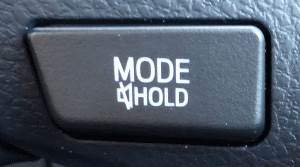 Sometimes it’s useful to be able to immediately mute the volume on the stereo. If your car is equipped with this, it will most likely be a button on the steering wheel. In the example shown, if you hold the button, it mutes the audio; if you just press the button briefly it changes the mode.
Sometimes it’s useful to be able to immediately mute the volume on the stereo. If your car is equipped with this, it will most likely be a button on the steering wheel. In the example shown, if you hold the button, it mutes the audio; if you just press the button briefly it changes the mode.
If you install a third-party car audio system then you’ll need to ensure that this button is wired in, too.
Seat adjustment (including headrest)
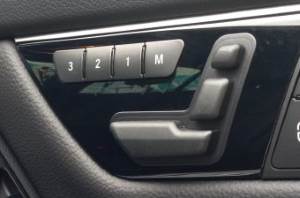 Seat adjustments will either be all manual, a mixture of manual and electric, or all electric. In some cars the headrest is electrically adjusted, too, for example in newer Mercedes-Benz models. Start by setting the seat squab (base) distance so that you can comfortably press the accelerator down all the way without your leg being completely straight.
Seat adjustments will either be all manual, a mixture of manual and electric, or all electric. In some cars the headrest is electrically adjusted, too, for example in newer Mercedes-Benz models. Start by setting the seat squab (base) distance so that you can comfortably press the accelerator down all the way without your leg being completely straight.
If you can adjust the seat height, a good rule of thumb is to adjust it so that your head doesn’t touch the roof, and you don’t bump your head getting in and out of the car, but have it as high as possible as this gives you the best view.
Then bring the seat back up so that you are comfortable and can reach the steering wheel so that your wrists can rest on the edge of the steering wheel when your arms are straight.
The image shows a Mercedes-Benz C200 with a huge number of variations, plus headrest adjustment and three memories.
Rear seat headrest removal
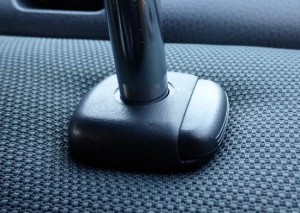 Some cars have compromised rear visibility because of headrests on the rear seats. If you carry passengers infrequently, then you could remove them altogether. On some vehicles, they flip down, and on others, you can just move them down to their lowest position. There will be a button on the collar on one of the pegs from the headrest into the rear seat that allows them to move.
Some cars have compromised rear visibility because of headrests on the rear seats. If you carry passengers infrequently, then you could remove them altogether. On some vehicles, they flip down, and on others, you can just move them down to their lowest position. There will be a button on the collar on one of the pegs from the headrest into the rear seat that allows them to move.
Of course, the headrests are there to reduce whiplash injuries in the case of a rear-end collision, as well as making it more comfortable for the passengers, so it’s not a good idea to carry rear seat passengers with them removed.
Airbag deactivation
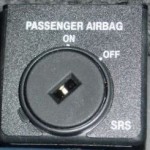 If you are carrying a baby in a carry cot in the front seat you will need to deactivate the passenger airbag. This is often by using the key in a keyhole in the glovebox. Check in your vehicle’s manual if it’s not there as some vehicles don’t have this option.
If you are carrying a baby in a carry cot in the front seat you will need to deactivate the passenger airbag. This is often by using the key in a keyhole in the glovebox. Check in your vehicle’s manual if it’s not there as some vehicles don’t have this option.
Power source – 12V, 120W
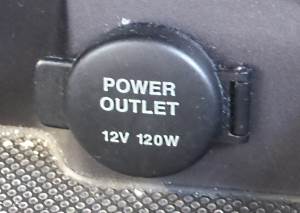 While you are driving you can use the cigarette lighter to recharge or power USB devices. All you need is an adapter like this and a USB cable to your device. This could be a smartphone, satellite navigation system, dashboard camera (find out about them by clicking here), etc.
While you are driving you can use the cigarette lighter to recharge or power USB devices. All you need is an adapter like this and a USB cable to your device. This could be a smartphone, satellite navigation system, dashboard camera (find out about them by clicking here), etc.

[…] It also helps if you check out our two guides on vehicle features which you can find here (first 12) and here (second 12). […]